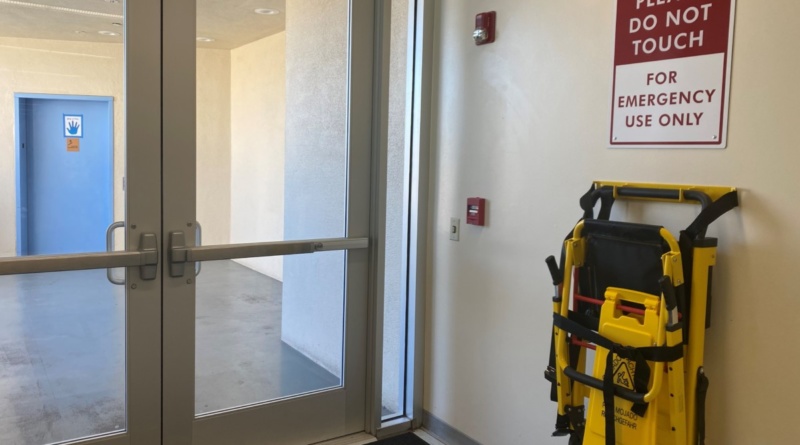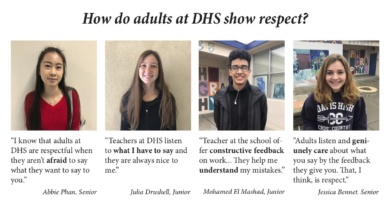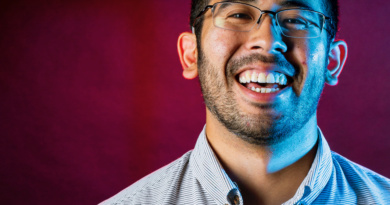Injured students’ experiences give insight into accessibility
PHOTO: An emergency wheelchair on the second floor of the library, ready to be used in case a disabled student needs to evacuate without a working elevator.
By Ayisi Ni,
BlueDevilHUB.com Staff–
After injuring her leg in volleyball last fall, junior Olivia Dirksen became aware of the physical challenges that being disabled poses. She underwent surgery, which put her in a wheelchair for a week. Even now, Dirksen has to use crutches to get around.
However, Dirksen says that she was pleasantly surprised that navigating the school campus was not that difficult. “When I first started out, I was really nervous about it. Going to school in a wheelchair, I was like ‘I don’t know how this is going to work’,” Dirksen said.
But that is not the experience of all students.
Sophomore Dylan Spatz, who injured himself over the summer, had to use crutches at school for several months. While over time he got used to getting around campus, he struggled inside his classrooms.
“The desks weren’t that great, since you couldn’t elevate my leg. Some teachers did offer a chair, but other than that: pretty uncomfortable,” Spatz said.
It was especially cramped in his science class, where Spatz had to sit at a desk that did not allow room for his leg to be properly extended or elevated.
“The lab tables had a lot of tall chairs so it would have been even more uncomfortable, so I just kinda propped up the other leg,” Spatz said.
Some science classes have accessible lab tables, which are several inches lower than normal ones, but Spatz did not see one in his class.
Science teacher Johnathan Langberg has an accessible lab table in his classroom but was not aware of it until recently.
“(Disabled students) pretty much can’t use the desks, since they are pretty small and the space I have for them is small as well. So they have to be stacked close together,” Langberg said.
Dirksen also faced challenges with her desks, but particularly struggled with the doors and door handles.
“That was probably the trickiest part of it, just because the doors are really heavy … I would try to open the door, then hold it open with one hand and someone else would push me in,” Dirksen said.
Eric Richardson, the performing arts facilities coordinator, says that heavy doors are a safety measure to prevent fires from spreading.
“They are designed to prevent fire from going one way or the other … If you can divide the building up into sections, it’s easier to contain the fire,” Richardson said.
Richardson, who manages the Richard Brunelle Performance Hall, says that the Brunelle conforms to accessibility standards. The theater has two elevators for wheelchairs, wide doors, a stage on street level and lighting in the audience area to guide people when it is dark.
“If someone has any kind of mobility issue, we need to make sure … that they can get to their seats without having to go up or down stairs,” Richardson said.
Another resource in Brunelle Hall is emergency wheelchairs, which can also be found in the two-story buildings and gyms on campus. These are folding yellow wheelchairs that ensure that in the case of an evacuation staff are equipped to carry disabled people down the stairs when elevators cannot be used.
For those who need access to elevators on a regular basis to reach second-story classrooms, the administration loans students a key with the caveat that they will be fined for failing to return it.
Ozana Milisic, a special education teacher, has overseen the needs of physically disabled students throughout her tenure at Davis High. She says that accessibility is something that DHS has handled well.
“Doors are wide enough, it’s flat, there are ramps available,” Milisic said. “We’ve had students before who required special seatings, so we installed that, and once they graduated, we removed it to ensure more space.”
Milisic also says that there are automatic doors at critical places on campus.
“(The) places that are highly frequented … do have better accessibility. There’s (an automatic door) in the cafeteria, there’s one in the library,” Milisic said.
Another important aspect of accessibility on campus is larger bathroom stalls, which according to Dirksen were necessary for her in a wheelchair. Her friends would push her chair in, which would not have been possible in the regular stall.
“I kinda always took (accessible stalls) for granted, since I’ve never needed to be in a wheelchair before,” Dirksen said.
Dirksen also emphasized how important it was for her to have support from her peers and teachers.
“I had people willing to push me around, which was really, really nice. All the teachers were really accommodating … I don’t think I could have done it by myself,” Dirksen said.




